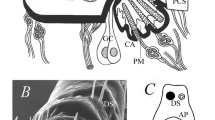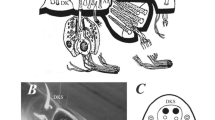Summary
Haller's organ on the tarsus of the tick Amblyomma americanum (L.) (Acarina: Ixodidae; nymphal stage) was studied by scanning and transmission electron microscopy. It consists of a distal bristle group, (the “anterior pit”), and a proximal “capsule” which encloses several sensilla. The seven sensilla of the anterior pit (A1–A7) are all thick-walled and multi-innervated (2–9 neurons), but at least three different types can be differentiated. Sensilla A1 and A2 possess large, plugged pores (>1000 Å) and are the only sensilla with branching dendrites. A3 and A5 are characterized by a spoke-wheel arrangement of the cuticle wall and very fine pores (100–200 Å) penetrating the “spokes” centrally; A4, A6, and A7 do not exhibit any pore system but a single opening at the bristle tip is assumed.
The capsule contains seven thin-walled, blunt-tipped sensilla, and several non-sensory cuticular projections (pleomorphs). All of these sensilla possess large “plugged” pores in the cuticle wall and numerous dendritic branches of several neurons (3–5) in the lumen. Glandular openings were found inside the capsule; their significance is discussed.
The fine structure of Haller's organ supports the functions postulated by Lees (1948), namely olfaction for the capsule and humidity reception (among others) for the anterior pit.
Zusammenfassung
Das Hallersche Organ auf dem Tarsus der Zecke Amblyomma americanum (L.) (Acarina: Ixodidae; Nymphenstadium) wurde mit dem Durchstrahlungs- und Rasterelektronenmikroskop untersucht. Es besteht aus einer distalen Sensillengruppe, die in einer flachen „Wanne“ gelegen ist, und einer proximalen „Kapsel“, welche mehrere Sensillen einschließt. Alle sieben Sensillen der „Wanne“ (A1–A7) sind dickwandig und mehrfach innerviert (2–9 Neurone), jedoch können mindestens 3 verschiedene Typen unterschieden werden: A1 und A2 besitzen große Poren (>1000 Å), die mit Pfropfen versehen sind, und sie sind zudem die einzigen Sensillen mit sich verzweigenden Dendriten; A3 und A5 sind durch eine radspeichenartige Anordnung der Cuticulawandung charakterisiert, ferner durch feine Poren (100–200 Å), welche die Speichen zentral durchziehen; A4, A6, und A7 zeigen kein Porensystem, doch wird eine einzelne Öffnung an der Spitze vermutet.
Die „Kapsel“ enthält 7 dünnwandige, stumpf endigende Sensillen und mehrere nichtsensorische Cuticulavorsprünge. Alle Sensillen besitzen große „Pfropfporen“ in der Cuticulawandung und zahlreiche dendritische Verzweigungen mehrerer Neuronen (3–5) im Lumen. Drüsenmündungen wurden in der „Kapsel“ festgestellt, ihre Bedeutung wird diskutiert.
Die Feinstruktur des Hallerschen Organs entspricht dem Postulat von Lees (1948), wonach die „Kapsel“ der Geruchsrezeption, die „Wanne“ der Feuchtigkeitsrezeption dienen soll.
Similar content being viewed by others
References
Borg, T. K., Norris, D. M.: Ultrastructure of sensory receptors on the antennae of Scolytus multistriatus (Marsh.). Z. Zellforsch. 113, 13–28 (1971).
Bruce, W. A.: Posterior capsule of Haller's organ in the lone star tick Amblyomma americanum (Acari: Ixodidae). The Florida Entomol. 54, 65–72 (1971).
Coons, L. B.: Fine structure of selected organ systems of the mite Macrocheles muscae domesticae (Acarina; Mesostigmata; Macrochelidae). Doct. thesis, N. C. State Univ., Raleigh, N. C. (1970).
Ernst, K. D.: Die Feinstruktur von Riechsensillen auf der Antenne des Aaskäfers Necrophorus (Coleoptera). Z. Zellforsch. 94, 72–102 (1969).
Foelix, R. F., Axtell, R. C.: Fine structure of tarsal sensilla in the tick Amblyomma americanum (L.). Z. Zellforsch. 114, 22–37 (1971).
Franke, W.W., Krien, S., Malcolm Brown, R.: Simultaneous glutaraldehyde-osmium tetroxide fixation with postosmication. An improved fixation procedure for electron microscopy of plant and animal cells. Histochemie 19, 162–164 (1969).
Ghidoni, J. J., Campbell, M. M., Adams, J. G., Thomas, H., Ramos, E. E.: A new multicolored staining procedure for one micron section of epoxy embedments. Proc. Electr. Micr. Soc. 26th Meeting, New Orleans, p. 240–241 (1968).
Ghiradella, H. T., Case, J. F., Cronshaw, J.: Structure of aesthetascs in selected marine and terrestrial decapods: Chemoreceptor morphology and environment. Amer. Zoologist 8, 603–621 (1968).
Haller, G.: Vorläufige Bemerkungen über das Gehörorgan der Ixodiden. Zool. Anz. 4, 165–167 (1881).
Haupt, J.: Beitrag zur Kenntnis der Sinnesorgane von Symphylen (Myriapoda). I. Elektronenmikroskopische Untersuchung des Trichobothriums von Scutigerella immaculata Newport. Z. Zellforsch. 110, 588–599 (1970).
Hindle, E., Merriman, G.: The sensory perceptions of Argas persicus (Oken). Parasitology 5, 203–216 (1912).
Lahille, F.: Contributions a l'étude des Ixodides de la République Argentine. Anales del Minist. Agric. Sección de Zootecnica, (Buenos Aires) 2, 107–109 (1905).
Lees, A. D.: Transpiration and the structure of the epicuticle in ticks. J. exp. Biol. 23, 379–410 (1947).
—: The sensory physiology of the sheep tick, Ixodes ricinus L. J. exp. Biol. 25, 145–207 (1948).
Locke, M., Collins, J. V.: The structure and formation of protein granules in the fat body of an insect. J. Cell Biol. 26, 857–884 (1965).
Myers, J.: The structure of the antennae of the Florida queen butterfly, Danaus gilippus berenice (Cramer). J. Morph. 125, 315–328 (1968).
Nuttall, G. H. F., Cooper, W. F., Robinson, L. E.: On the structure of Haller's organ in the Ixodoidea. Parasitology 1, 238–243 (1908).
Schneider, D., Steinbrecht, R. A.: Checklist of insect olfactory sensilla. Symp. zool. Soc. Lond. 23, 279–297 (1968).
Schulze, P.: Das Geruchsorgan der Zecken. Untersuchungen über die Abwandlungen eines Sinnesorgans und seine stammesgeschichtliche Bedeutung. Z. Morph. Ökol. Tiere 37, 491–564 (1941).
—: Über die Hautsinnesorgane der Zecken, besonders über eine bisher unbekannte Art von Arthropodensinnesorganen, die Krobylophoren. Z. Morph. Ökol. Tiere 38, 379–419 (1942).
Slifer, E. H.: A rapid and sensitive method for identifying permeable areas in the body wall of insects. Entom. News 71, 179–182 (1960).
—: The structure of arthropod chemoreceptors. Ann. Rev. Entomol. 15, 121–142 (1970).
Steinbrecht, R. A.: Comparative morphology of olfactory receptors. In: Olfaction and taste, ed. by C. Pfaffmann, p. 3–21. New York: Rockefeller Univ. Press 1969.
- Stimulus transfering tubules in insect olfactory receptors. Septième Congr. Int. Micr. Electr., Grenoble, p. 947–948 (1970).
Totze, R.: Beiträge zur Sinnesphysiologie der Zecken. Z. vergl. Physiol. 19, 110–161 (1933).
Waldow, U.: Elektrophysiologische Untersuchungen an Feuchte-, Trocken- und Kälterezeptoren auf der Antenne der Wanderheuschrecke Locusta. Z. vergl. Physiol. 69, 249–283 (1970).
Yalvaç, S.: Histologische Untersuchungen über die Entwicklung des Zeckenadultus in der Nymphe. Z. Morph. Ökol. Tiere 35, 535–585 (1939).
Zolotarev, E. Kh., Elizarov, Yu. A.: Studies of chemoreception in insects and ticks. Location of the chemoreceptors in the tick Ixodes persulcatus P. Sch. Vestn. Mosk. Univ. 18, 7–9 (1963).
—: Investigation of the chemoreception in insects and ticks: The pecularities of the functioning of chemoreceptors in Hyalomma asiaticum P. Sch. et E. Sch. under the action of repellents. Zool. J. Mosk. 43, 549–559 (1964).
—, Sinitsyna, Ye. Ye.: Chemoreceptive organs on the fore legs of ixodid ticks. Vestn. Mosk. Univ. 20, 17–25 (1965).
Author information
Authors and Affiliations
Additional information
This research was supported in part by the Office of Naval Research, and by NIH Training grant ES 00069. Paper no. 3459 of the Journal Series of the North Carolina State University Agricultural Experiment Station, Raleigh.
Rights and permissions
About this article
Cite this article
Foelix, R.F., Axtell, R.C. Ultrastructure of Haller's organ in the tick Amblyomma americanum (L.). Z. Zellforsch. 124, 275–292 (1972). https://doi.org/10.1007/BF00355031
Received:
Issue Date:
DOI: https://doi.org/10.1007/BF00355031




